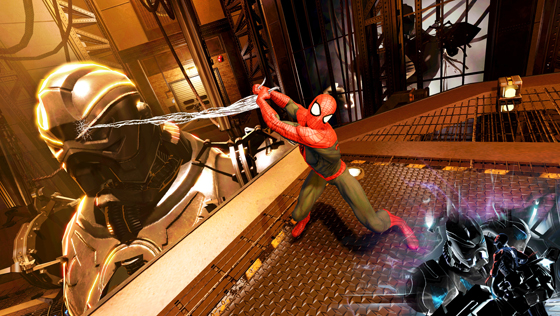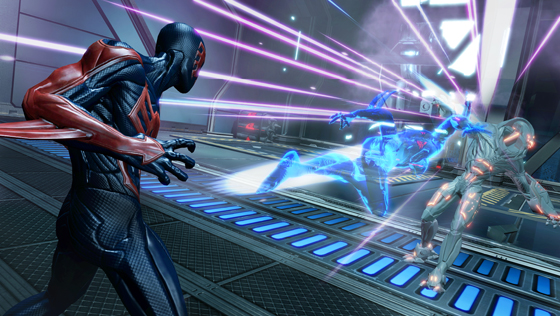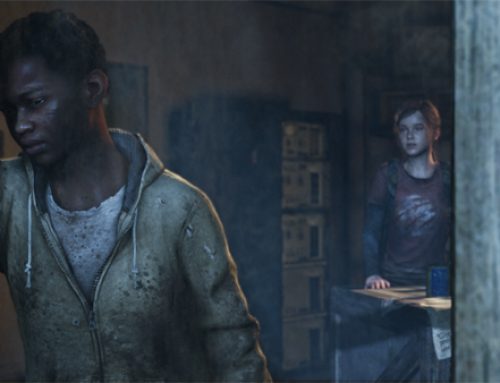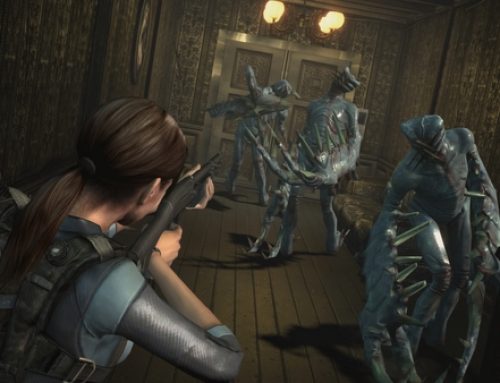
"Spider-Man: Edge of Time's" linear narrative might conflict with its desire to explore the ability of the Amazing Spider-Man to affect the future of Spider-Man 2099, bottom right.
“Spider-Man: Edge of Time,” which made its public debut recently at Wonder-Con in San Francisco, plays with the possibility of time travel and alternate timelines. Though it’s next to impossible to assess the quality of an upcoming game based on a first look trailer and watching someone else play for 15 minutes, I came away from a preview event for journalists slightly disappointed that “Edge of Time” seems very much locked into a movie and comic-book style of storytelling.
Though it’s not a sequel, “Edge of Time,” planned for a fall release, is being developed by Beenox, who made last year’s well-received “Spider-Man: Shattered Dimensions.” It tells the story of two “Spider-Men” (“Spider-Mans?”) — Peter Parker, aka The Amazing Spider-Man, and Miguel O’Hara, aka Spider-Man 2099, a familiar face to comic book fans.
“Edge of Time” picks up with O’Hara reaching out to Peter Parker across time, trying to warn him of a plot to kill the Amazing Spider-Man, along with plenty of innocent people. Parker’s immediate response, of course, is “Scores of innocent people are going to die? I must save them!” and he proceeds to walk right into the trap that O’Hara is trying to warn him about in the first place.
From there the levels of the game progress, with the two Spideys trying to work together across time to restore a proper time frame, foiling a plot by a criminal mastermind in 2099, while also preventing the Amazing Spider-Man’s death in Parker’s timeline.
I got to see a little of how this would work in action. As the Amazing Spider-Man journeyed through modern-day factory and destroyed prototypes of weaponry that Spider-Man 2099 was fighting in his timeline, you could see O’Hara fighting to survive in the lower-righthand corner of your screen. This picture-in-picture display of the timelines is something we’ll see often, whether we’re playing as Amazing or 2099, and feels quite appropriate given Spider-Man’s comic book roots.
It’s a cool way to tell a story and if it’s done right, I could see it resonating well with Spider-Man fans, particularly those who’ve wanted to see a starring role for Spider-Man 2099. (2099 creator Peter David helped write the game’s story.)
As a gamer, though, I felt a little let down by what looks to be a fairly linear story that unfolds primarily the same way for everybody. At the end of the session, I asked Beenox’s Gerard Lehiany and Activision’s Kevin Umbricht how much players of “Edge of Time” will be able to influence the game’s timeline. The answer was that the game would have a “set narrative but the cause and effect works in different ways.” The core events in the game would be the same for everyone, in other words, but there might be a few variables thrown in.
It’s here where I wonder, however good “Edge of Time” ends up being, if Beenox isn’t missing an opportunity. After all, if your game is all about two superheroes working across different timelines to change history for the greater good, is it appropriate to lock your players into a set narrative that their actions cannot alter?
Choose-Your-Own Adventure books and tabletop role-playing games excepted, video games stand alone in their ability to tell a story that plays out in several different ways. Players of Bioware’s role-playing games or even of action-oriented fare like “Star Wars: The Force Unleashed” get invested in stories that unfold differently based on their choices, successes and failures. Obviously, it’d be a lot more work from a programming and licensing standpoint to tell a “Spider-Man” story that lets gamers toy with the possibility of rewriting the histories of two iconic characters. But it might be the difference between making a great video game, and a great interactive comic.
None of this means, of course, that “Edge of Time” won’t be worth playing. What I saw had the makings of a decent action title, with plenty of wall-walking, web-slinging and other cool moves. The addition of Spider-Man 2099 to the mix means the Beenox crew can work in another set of futuristic abilities. I got to see Spider-Man 2099 distract enemies with a holographic decoy, for example. It’ll also be fun flipping back and forth between the Amazing Spider-Man’s more acrobatic style of fighting and O’Hara’s more “barbaric” style as Umbricht put it. All of the two Spideys’ various abilities can be chained together and upgraded, which should appeal to my “Bayonetta”- and “Ninja Gaiden”-loving sensibilities.
Even if the story isn’t as malleable as I’d like it to be, we’ll also get to see plenty of character development and interesting dialogue between two Spider-Men with different goals and personalities.
“They don’t hit it off like ‘Hey, you’re a Spider-Man? I’m a Spider-Man, too!’ They have to learn how to trust each other over time,” Lehiany said. In particular, the more self-centered O’Hara will have to learn to work alongside the more altruistic Parker. Since the two Spider-Men effectively keep an open channel of communication throughout the game, there’ll be ample opportunity for back-and-forth dialogue.
Spider-Man fans will get to experience this repartee themselves when the game launches this fall on Xbox 360 and PlayStation 3.




